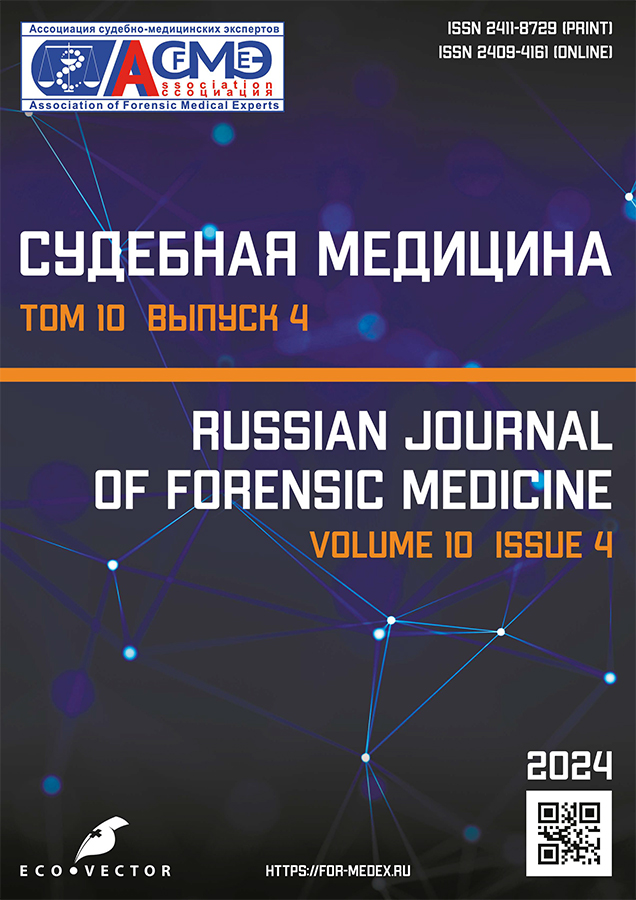Forensic medical analysis of head injuries in drivers sustaining fatal in-vehicle trauma
- Authors: Grukhovskiy S.V.1,2, Velenko P.S.2, Bychkov A.А.1,2, Marchenkov R.E.2, Globa I.V.2, Berezovskiy D.P.2, Barinov E.K.3,4
-
Affiliations:
- Bureau of forensic medical examination of the Department of health of the city of Moscow
- The First Sechenov Moscow State Medical University
- Russian University of Medicine
- Peoples' Friendship University of Russia
- Issue: Vol 10, No 4 (2024)
- Pages: 509-516
- Section: Original study articles
- Submitted: 02.05.2024
- Accepted: 07.11.2024
- Published: 05.12.2024
- URL: https://for-medex.ru/jour/article/view/16134
- DOI: https://doi.org/10.17816/fm16134
- ID: 16134
Cite item
Abstract
Background: One of the primary tasks of a forensic medical expert in examinations related to in-vehicle trauma is determining the mechanism of injury formation, its severity, and the position of the victim. This often requires addressing questions regarding the specific mechanisms of traumatic brain injury, its morphology, and its severity.
Aim: To study the characteristics of head injuries sustained by drivers in fatal in-vehicle automobile trauma.
Materials and methods: Expert reports from the Bureau of Forensic Medical Examination of the Moscow Department of Health from 2006 to 2013 were analyzed to assess the presence and localization of head injuries in drivers involved in road traffic accidents. The Injury Severity Score (ISS) was used to assess the severity of traumatic brain injuries in drivers of domestic and foreign-manufactured vehicles.
Results: The study found no significant differences between the comparison groups in the ISS score ranges of 0–10 and 11–20 points. However, in the ISS score ranges of 21–30 and 31–40 points, fatal injuries were more prevalent among drivers of domestic vehicles, while in the 41–50 point range, they were more common among drivers of foreign-manufactured vehicles.
Conclusion: In cases of fatal traumatic brain injury, significant differences in injury localization and severity suggest the presence of additional factors that require further investigation and should be considered when determining the victim’s position in the vehicle at the time of the accident.
Full Text
About the authors
Sergey V. Grukhovskiy
Bureau of forensic medical examination of the Department of health of the city of Moscow; The First Sechenov Moscow State Medical University
Author for correspondence.
Email: gruhovskiy@mail.ru
ORCID iD: 0000-0001-9849-7825
SPIN-code: 7734-4020
Russian Federation, Moscow; Moscow
Pavel S. Velenko
The First Sechenov Moscow State Medical University
Email: velenko_p_s_1@staff.sechenov.ru
ORCID iD: 0000-0003-2800-1454
SPIN-code: 6649-3580
MD, Cand. Sci. (Medicine), Assistant Professor
Russian Federation, MoscowAlexey А. Bychkov
Bureau of forensic medical examination of the Department of health of the city of Moscow; The First Sechenov Moscow State Medical University
Email: bychkov_a_a@staff.sechenov.ru
ORCID iD: 0000-0001-6741-6498
SPIN-code: 4042-7275
MD, Cand. Sci. (Medicine), Assistant Professor
Russian Federation, Moscow; MoscowRuslan E. Marchenkov
The First Sechenov Moscow State Medical University
Email: marchenkov_r_e@student.sechenov.ru
ORCID iD: 0000-0001-5705-522X
SPIN-code: 3116-5490
Russian Federation, Moscow
Irina V. Globa
The First Sechenov Moscow State Medical University
Email: globa_i_v@staff.sechenov.ru
ORCID iD: 0000-0002-7185-4324
SPIN-code: 3976-6782
MD, Cand. Sci. (Medicine), Assistant Professor
Russian Federation, MoscowDmitriy P. Berezovskiy
The First Sechenov Moscow State Medical University
Email: berezovskiy_d_p@staff.sechenov.ru
ORCID iD: 0000-0002-8502-1331
SPIN-code: 4063-5837
MD, Dr. Sci. (Medicine), Professor
Russian Federation, MoscowEvgeny Kh. Barinov
Russian University of Medicine; Peoples' Friendship University of Russia
Email: ev.barinov@mail.ru
ORCID iD: 0000-0003-4236-4219
SPIN-code: 2112-4568
MD, Dr. Sci. (Medicine), Professor
Russian Federation, Moscow; MoscowReferences
- Anuprienko SA, Pron ES, Barmakova JS, Porodenko VА. Children's non-fatal road traffic injury in Krasnodar in 2015–2019. Russ J Forensic Medicine. 2021;7(1):10–20. EDN: ZVSHLL doi: 10.17816/fm335
- Badalyan AF, Novoselov VP. Forensic medical estimation of the vehicle speed considering the morphological features of blood traces. Bull Forensic Medicine. 2018;7(2):4–7. EDN: XSZDPV
- Indiaminov SI, Ismailov RA, Bakhtiyorov BB. Injuries in drivers caused by an in-vehicle car trauma. Vestnik sovremennoi klinicheskoi mediciny = The bulletin of contempopary clinical medicine. 2020;13(5):20–25. EDN: AEAWEY doi: 10.20969/VSKM.2020.13(5).20-25
- Maksimov AV, Kuchuk SA. Characteristics of fatal road traffic injuries in the Moscow region. Russ J Forensic Medicine. 2020;6(3):36–40. EDN: XPVCSF doi: 10.19048/fm322
- Bychkov AA, Dubrovin IA, Gerasimov AN, et al. Comparative characteristics of injuries to individual body parts of the driver and passengers inside the passenger compartment of a moving vehicle in a traffic accident. Sudebno-meditsinskaia ekspertiza = Forensic medical expertise. 2019;62(3):12–16. EDN: ZTAOLR doi: 10.17116/sudmed20196203112
- Dubrovin IA, Mosoian AS, Grukhovskiy SV, Bychkov AA. General characteristics of the driver’s head injury in road accidents. Sudebno-meditsinskaia ekspertiza = Forensic medical expertise. 2020;63(2):19–24. EDN: FWIBWB doi: 10.17116/sudmed20206302119
- Baker CE, Martin P, Wilson MH, et al. The relationship between road traffic collision dynamics and traumatic brain injury pathology. Brain Commun. 2022;4(2):fcac033. EDN: KWXWYG doi: 10.1093/braincomms/fcac033
- Al-Thaifani AA, Al-Rabeei NA, Dallak AM. Study of the Injured persons and the injury pattern in road traffic accident in Sana’a city, Yemen. Advances in public health. 2016;2016(3):1–5. doi: 10.1155/2016/4138163
- Bolorunduro OB, Villegas C, Oyetunji TA, et al. Validating the Injury Severity Score (ISS) in different populations: ISS predicts mortality better among Hispanics and females. J Surg Res. 2011;166(1):40–44. doi: 10.1016/j.jss.2010.04.012
Supplementary files









